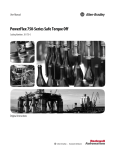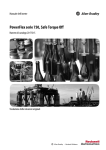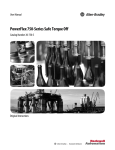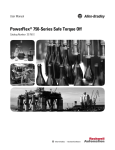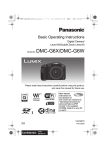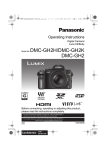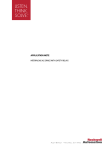Download DriveGuard Safe Torque Off Option for PowerFlex 700S/700L AC
Transcript
User Manual Safe Torque Off Option for PowerFlex 700S Phase II AC Drives and PowerFlex 700L Liquid-Cooled AC Drives Catalog Number 20D-P2-DG01 Original Instructions Important User Information Solid state equipment has operational characteristics differing from those of electromechanical equipment. Safety Guidelines for the Application, Installation and Maintenance of Solid State Controls (Publication SGI-1.1 available from your local Rockwell Automation sales office or online at http://www.rockwellautomation.com/ literature/) describes some important differences between solid-state equipment and hard-wired electromechanical devices. Because of this difference, and also because of the wide variety of uses for solid state equipment, all persons responsible for applying this equipment must satisfy themselves that each intended application of this equipment is acceptable. In no event will Rockwell Automation, Inc. be responsible or liable for indirect or consequential damages resulting from the use or application of this equipment. The examples and diagrams in this manual are included solely for illustrative purposes. Because of the many variables and requirements associated with any particular installation, Rockwell Automation, Inc. cannot assume responsibility or liability for actual use based on the examples and diagrams. No patent liability is assumed by Rockwell Automation, Inc. with respect to use of information, circuits, equipment, or software described in this manual. Reproduction of the contents of this manual, in whole or in part, without written permission of Rockwell Automation, Inc. is prohibited. Throughout this manual, when necessary we use notes to make you aware of safety considerations. WARNING: Identifies information about practices or circumstances that can cause an explosion in a hazardous environment, which may lead to personal injury or death, property damage, or economic loss. ATTENTION: Identifies information about practices or circumstances that can lead to personal injury or death, property damage, or economic loss. Attentions help you identify a hazard, avoid a hazard, and recognize the consequences. SHOCK HAZARD: Labels may be on or inside the equipment, for example, a drive or motor, to alert people that dangerous voltage may be present. BURN HAZARD: Labels may be on or inside the equipment, for example, a drive or motor, to alert people that surfaces may reach dangerous temperatures. IMPORTANT Identifies information that is critical for successful application and understanding of the product. Allen-Bradley, Rockwell Software, Rockwell Automation, and TechConnect are trademarks of Rockwell Automation, Inc. Trademarks not belonging to Rockwell Automation are property of their respective companies. Summary of Changes This manual contains new and updated information. New and Updated Information The following changes apply to this revision of the manual. Change Added “Original Instructions” to the front cover. Updated the Important statement regarding the proper use of the Safe Torque Off option. Updated the information in the Evaluation/Certification by TÜV Rheinland Group table to support frame 5 and 6 and frames 9…14 drives. Updated the information in the PFD and PFH for 20-year Proof Test Interval table to support frame 9…14 drives. Added steps for installing the Safe Torque Off option board in frame 9…14 drives. Added frames 9…14 drives to wiring diagram example 2. Rockwell Automation Publication 20D-UM007G-EN-P - March 2012 See Page… – 7 9 12 17 32 3 Summary of Changes 4 Rockwell Automation Publication 20D-UM007G-EN-P - March 2012 Table of Contents Chapter 1 General Description What Is the DriveGuard Safe Torque Off Option? . . . . . . . . . . . . . . . 7 Safety of Machinery Standards . . . . . . . . . . . . . . . . . . . . . . . . . . . . . . . . . 8 Safety Certifications. . . . . . . . . . . . . . . . . . . . . . . . . . . . . . . . . . . . . . . . . . . 9 Evaluation/Certification by TÜV Rheinland Group . . . . . . . . . . 9 Certifications Online. . . . . . . . . . . . . . . . . . . . . . . . . . . . . . . . . . . . . . . 9 Important Safety Considerations . . . . . . . . . . . . . . . . . . . . . . . . . . . . . . 10 Safety Category 3 Performance Definition . . . . . . . . . . . . . . . . . . . . . 11 Stop Category Definitions . . . . . . . . . . . . . . . . . . . . . . . . . . . . . . . . . . . . 11 Performance Level and Safety Integrity Level (SIL) CL2. . . . . . . . . 12 PFD and PFH Definitions . . . . . . . . . . . . . . . . . . . . . . . . . . . . . . . . . . . . 12 PFD and PFH Data . . . . . . . . . . . . . . . . . . . . . . . . . . . . . . . . . . . . . . . . . . 12 PFD and PFH for 20-year Proof Test Interval . . . . . . . . . . . . . . . 12 Functional Proof Tests . . . . . . . . . . . . . . . . . . . . . . . . . . . . . . . . . . . . . . . . 13 Contact Information if Safety Option Failure Occurs . . . . . . . . . . . 13 Chapter 2 Installation and Wiring Pre-Installation Instructions. . . . . . . . . . . . . . . . . . . . . . . . . . . . . . . . . . . 15 Option Board Installation . . . . . . . . . . . . . . . . . . . . . . . . . . . . . . . . . . . . 16 PowerFlex 700S Frames 1…6 and PowerFlex 700L Frames 3A and 3B . . . . . . . . . . . . . . . . . . . . . . . . . . . . . . . . . . . . . . . . . . . . . . . . 16 PowerFlex 700S Frames 9…14 . . . . . . . . . . . . . . . . . . . . . . . . . . . . . . 17 PowerFlex 700S, All Frames, and PowerFlex 700L, Frame 3 . . . 18 PowerFlex 700S Frames 1…6 . . . . . . . . . . . . . . . . . . . . . . . . . . . . . . . 23 PowerFlex 700S Frames 9…14 . . . . . . . . . . . . . . . . . . . . . . . . . . . . . . 23 PowerFlex 700L Frames 3A and 3B . . . . . . . . . . . . . . . . . . . . . . . . . 24 Wiring . . . . . . . . . . . . . . . . . . . . . . . . . . . . . . . . . . . . . . . . . . . . . . . . . . . . . . 25 Configure Hardware Enable . . . . . . . . . . . . . . . . . . . . . . . . . . . . . . . . . . 26 Configure Digital Outputs. . . . . . . . . . . . . . . . . . . . . . . . . . . . . . . . . . . . 27 Linking Parameters. . . . . . . . . . . . . . . . . . . . . . . . . . . . . . . . . . . . . . . . . . . 27 Verify Operations . . . . . . . . . . . . . . . . . . . . . . . . . . . . . . . . . . . . . . . . . . . . 28 Rockwell Automation Publication 20D-UM007G-EN-P - March 2012 5 Table of Contents Chapter 3 Description of Operation DriveGuard Safe Torque Off Operation . . . . . . . . . . . . . . . . . . . . . . . . 29 Connection Examples . . . . . . . . . . . . . . . . . . . . . . . . . . . . . . . . . . . . . . . . 31 Example 1 - PowerFlex 700S Drives, Frames 1…6 Safe Torque Off Connection with Coast-to-Stop Action, Dual Channel. . . . . . . . . . . . . . . . . . . . . . . . . . . . . . . . . . . . . . . . . . . . . . . . . . 31 Example 2 - PowerFlex 700S Drives, Frames 9…14 and PowerFlex 700L Drives, Frames 3A and 3B Safe Torque Off Connection with Coast-to-Stop Action, Dual Channel. . . . . . . . . . . . . . . . . . . . . . . . . . . . . . . . . . . . . . . . . . . . . . . . . . 32 Example 3 - All Drives Safe Torque Off Connection with Controlled Stop Action, Dual Channel. . . . . . . . . . . . . . . . . . . . . . . . . . . . . . . . . . . . . . . . . . . . . . . . . . 33 Index 6 Rockwell Automation Publication 20D-UM007G-EN-P - March 2012 Chapter 1 General Description The DriveGuard Safe Torque Off option, when used with other safety components, helps provide protection to meet the requirements for SIL CL2 and Category 3 or PL d class applications. Safety requirements are based on the standards current at the time of certification. The DriveGuard Safe Torque Off option is just one component in a safety control system. Components in the system must be chosen and applied appropriately to achieve the desired level of operator safeguarding. What Is the DriveGuard Safe Torque Off Option? The DriveGuard Safe Torque Off option: • Is designed to help safely remove power from the gate firing circuits of the drive’s output power devices (IGBT’s). This helps prevent the drive’s output power devices from switching in the pattern necessary to generate rotation at the motor. • Can be used in combination with other safety devices to satisfy the Safe Torque Off requirements of SIL CL2, according to EN 61800-5-2, IEC 61508, and EN 62061 Performance Level PL d and Category 3 according to EN ISO 13849-1. IMPORTANT This option is suitable for performing mechanical work on the drive system or affected area of a machine only. It does not provide electrical safety. For electrical maintenance on the drive and/or motor, equipment must be electrically disconnected from the power source. The Safe Torque Off option should not be used for non safety-related stopping of the drive. Rockwell Automation Publication 20D-UM007G-EN-P - March 2012 7 Chapter 1 General Description ATTENTION: Electrical Shock Hazard. Verify that all sources of AC and DC power are de-energized and locked out or tagged out in accordance with the requirements of ANSI/NFPA 70E, Part II. ATTENTION: To avoid an electric shock hazard, verify that the voltage on the bus capacitors has discharged before performing any work on the drive. Measure the DC bus voltage at the +DC and -DC terminals or test points (refer to your drive’s User Manual for locations). The voltage must be zero. ATTENTION: In Safe Torque Off mode, hazardous voltages may still be present at the motor. To avoid an electric shock hazard, disconnect power to the motor and verify that the voltage is zero before performing any work on the motor. ATTENTION: In the event of the failure of two output IGBTs in the drive, when the DriveGuard Safe Torque Off option has controlled the drive outputs to the off state, the drive may provide energy for up to 180° of rotation in a 2-pole motor before torque production in the motor ceases. Safety of Machinery Standards The DriveGuard Safe Torque Off option meets the following council directives and the requirements of the following machine safety standards: 8 • EN 61800-5-2:2007 Adjustable Speed Electrical Power Drives Systems – Part 5-2 Safety Requirements: Functional • EN ISO 13849-1:2008 Safety of Machinery – Safety-related parts of control systems - Part 1: General Principles for Design • EN 62061:2005 Safety of Machinery, Functional safety of safety-related electrical, electronic and programmable electronic control systems • EN 60204-1:2006 Safety of Machinery – Electrical equipment of machines – Part 1: General Requirements • IEC 61508 Part 1-7:1998, 2000, and 2010 Functional safety of electrical / electronic / programmable electronic safety-related systems Rockwell Automation Publication 20D-UM007G-EN-P - March 2012 General Description Chapter 1 Safety Certifications The TÜV Rheinland group has approved the DriveGuard Safe Torque Off option for use in safety-related applications where the de-energized state is considered to be the safe state. All of the examples related to I/O included in this manual are based on achieving de-energization as the safe state for typical Machine Safety and Emergency Shutdown (ESD) systems. Evaluation/Certification by TÜV Rheinland Group Drive Rating PowerFlex 700S 208/240V and 400/480V Phase II Frames 1…6 600/690V Frames 5 and 6 400/480V and 600/690V Frames 9…14 PowerFlex 700L 400/480V and 600/690V Liquid-Cooled Frames 3A and 3B TUV Report on Safety Function & TUV Certification TUV Certificate No. 01/205/5195/12 TUV Report No. 968/EZ 189.01/09 TUV Certificate No. 01/205/5195/12 TUV Report No. 968/EZ 189.02/12 TUV Report and Certificate No. 968/EZ 230.00/06 TUV Certificate No. 01/205/0667/09 TUV Report No. 968/EZ 230.02/09 Certifications Online See the Product Certifications link at http://ab.com for Declarations of Conformity, Certificates, and other certifications details. Rockwell Automation Publication 20D-UM007G-EN-P - March 2012 9 Chapter 1 General Description Important Safety Considerations The system user is responsible for: • the set-up, safety rating, and validation of any sensors or actuators connected to the system. • completing a system-level risk assessment and reassessing the system any time a change is made. • certification of the system to the desired safety performance level. • project management and proof testing. • programming the application software and the safety option configurations in accordance with the information in this manual. • access control to the system, including password handling. • analyzing all configuration settings and choosing the proper setting to achieve the required safety rating. IMPORTANT When applying Functional Safety, restrict access to qualified, authorized personnel who are trained and experienced. ATTENTION: When designing your system, consider how personnel will exit the machine if the door locks while they are in the machine. Additional safeguarding devices may be required for your specific application. 10 Rockwell Automation Publication 20D-UM007G-EN-P - March 2012 General Description Chapter 1 Safety Category 3 Performance Definition To achieve Safety Category 3 according to EN ISO 13849-1:2008, the safety-related parts have to be designed such that: • the safety-related parts of machine control systems and/or their protective equipment, as well as their components, shall be designed, constructed, selected, assembled, and combined in accordance with relevant standards so that they can withstand expected conditions. • well tried safety principles shall be applied. • a single fault in any of its parts does not lead to a loss of safety function. • some but not all faults will be detected. • the accumulation of undetected faults can lead to loss of safety function. • short circuits in the external wiring of the safety inputs is not one of the faults that can be detected by the system, therefore, according to DIN EN ISO 13549-2, these cables must be installed so as to be protected against external damage by cable ducting or armor. Stop Category Definitions The selection of a stop category for each stop function must be determined by a risk assessment. • Stop Category 0 is achieved with immediate removal of power to the actuator, resulting in an uncontrolled coast to stop. See “Description of Operation” Example 1 on page 31 and Example 2 on page 32. • Stop Category 1 is achieved with power available to the machine actuators to achieve the stop. Power is removed from the actuators when the stop is achieved. See “Description of Operation” Example 3 on page 33. IMPORTANT When designing the machine application, timing and distance should be considered for a coast to stop (Stop Category 0 or Safe Torque Off). For more information regarding stop categories, refer to EN 60204-1. Rockwell Automation Publication 20D-UM007G-EN-P - March 2012 11 Chapter 1 General Description Performance Level and Safety Integrity Level (SIL) CL2 For safety-related control systems, Performance Level (PL), according to EN ISO 13849-1, and SIL levels, according to IEC 61508 and EN 62061, include a rating of the system’s ability to perform its safety functions. All of the safety-related components of the control system must be included in both a risk assessment and the determination of the achieved levels. Refer to the EN ISO 13849-1, IEC 61508, and EN 62061 standards for complete information on requirements for PL and SIL determination. PFD and PFH Definitions Safety-related systems can be classified as operating in either a Low Demand mode, or in a High Demand/Continuous mode. • Low Demand mode: where the frequency of demands for operation made on a safety-related system is no greater than one per year or no greater than twice the proof-test frequency. • High Demand/Continuous mode: where the frequency of demands for operation made on a safety-related system is greater than once per year or greater than twice the proof test interval. The SIL value for a Low Demand safety-related system is directly related to order-of-magnitude ranges of its average probability of failure to satisfactorily perform its safety function on demand or, simply, average probability of failure on demand (PFD). The SIL value for a High Demand/Continuous mode safety-related system is directly related to the probability of a dangerous failure occurring per hour (PFH). PFD and PFH Data These PFD and PFH calculations are based on the equations from Part 6 of IEC 61508 and show worst-case values. This table provides data for a 20-year proof test interval and demonstrates the worst-case effect of various configuration changes on the data. PFD and PFH for 20-year Proof Test Interval Attribute Test Result Frames 1…6 5.28 x 10-5 PFDav PFH 6.00 x 10-10 1/h (calculated according to IEC 61508) MTTFD High (4023 years) low (69%) DCav 12 Test Result Frames 9…14 2.14 x 10-4 2.64 x 10-9 1/h (calculated according to IEC 61508) High (11415 years) low (80%) Rockwell Automation Publication 20D-UM007G-EN-P - March 2012 General Description Chapter 1 Functional Proof Tests The functional safety standards require that functional proof tests be performed on the equipment used in the system. Proof tests are performed at user-defined intervals and are dependent upon PFD and PFH values. IMPORTANT Your specific application determines the time frame for the proof test interval. Contact Information if Safety Option Failure Occurs If you experience a failure with any safety-certified device, contact your local Rockwell Automation distributor. With this contact, you can: • return the device to Rockwell Automation so the failure is appropriately logged for the catalog number affected and a record is made of the failure. • request a failure analysis (if necessary) to determine the probable cause of the failure. Rockwell Automation Publication 20D-UM007G-EN-P - March 2012 13 Chapter 1 General Description Notes: 14 Rockwell Automation Publication 20D-UM007G-EN-P - March 2012 Chapter 2 Installation and Wiring Pre-Installation Instructions Installation must be in accordance with the following steps and must be carried out by competent personnel. The DriveGuard Safe Torque Off option is intended to be part of the safety related control system of a machine. Before installation, a risk assessment should be performed that compares the DriveGuard Safe Torque Off option specifications and all foreseeable operational and environmental characteristics of the machine to which it is to be fitted. A safety analysis of the machine section controlled by the drive is required to determine how often the safety function should be tested for proper operation during the life of the machine. ATTENTION: The following information is merely a guide for proper installation. Rockwell Automation, Inc. cannot assume responsibility for the compliance or the noncompliance to any code, national, local or otherwise for the proper installation of this equipment. A hazard of personal injury and/or equipment damage exists if codes are ignored during installation. Rockwell Automation Publication 20D-UM007G-EN-P - March 2012 15 Chapter 2 Installation and Wiring Option Board Installation PowerFlex 700S Frames 1…6 and PowerFlex 700L Frames 3A and 3B 1. Remove the I/O Control Cassette from the drive. Task Description Open the door of the power structure and disconnect the cables that connect to A the main board. Loosen the screws on the face of the cassette. B Remove the cassette. C B (PowerFlex 700S shown) A C 16 Rockwell Automation Publication 20D-UM007G-EN-P - March 2012 Installation and Wiring Chapter 2 PowerFlex 700S Frames 9…14 1. Remove the I/O Control Cassette from the drive. Task Description Open the door of the power structure and carefully disconnect the three cables A that connect to the main board. Loosen the thumb screw that holds the metal flange in place. B C Swing the flange and cassette away from the control frame. D Loosen the screws on the face of the cassette. E Remove the cassette. A B Typical Frames 10…14 C E D Rockwell Automation Publication 20D-UM007G-EN-P - March 2012 17 Chapter 2 Installation and Wiring PowerFlex 700S, All Frames, and PowerFlex 700L, Frame 3 2. Remove the screws securing the interior cassette cover to gain access to the Main board. 3. Remove the 2-pin shunt jumper from the 16-15 pin position. 16 15 IMPORTANT 18 If the DriveGuard Safe Torque Off option is removed from the drive, this jumper must be reinstalled or the drive will not run. Rockwell Automation Publication 20D-UM007G-EN-P - March 2012 Installation and Wiring Chapter 2 4. Remove the exterior cassette covers to access the grounding plate. Rockwell Automation Publication 20D-UM007G-EN-P - March 2012 19 Chapter 2 Installation and Wiring 5. Install the 16-pin stacker connector. 6. Plug the DriveGuard Safe Torque Off option into the 16-pin connector. 0.8…1.1 N•m (7.0…10.0 lb•in) 7. Install and tighten mounting screws. 20 Rockwell Automation Publication 20D-UM007G-EN-P - March 2012 Installation and Wiring Chapter 2 8. Install the exterior cassette covers. ➋ ➊ Rockwell Automation Publication 20D-UM007G-EN-P - March 2012 21 Chapter 2 Installation and Wiring 9. Install the inside front cover. 0.8…1.1 N•m (7.0…10.0 lb•in) 10. Reinstall the cassette in the drive. 11. Record the modification on the Field Installed Option label. 22 Rockwell Automation Publication 20D-UM007G-EN-P - March 2012 Installation and Wiring Chapter 2 PowerFlex 700S Frames 1…6 FIELD INSTALLED OPTIONS Firmware Firmware 20-HIM 28-IO20-COMM20B_-DB1- #: #: Date Date HIM I/O COM Module Internal Dynamic Brake Use marker to note addition of DriveGuard Safe Torque Off option. PowerFlex 700S Frames 9…14 Use marker to note addition of DriveGuard Safe Torque Off option. FIELD INSTALLED OPTIONS Firmware Firmware 20-HIM 28-IO20-COMM20B_-DB1- #: #: Date Date HIM I/O COM Module Internal Dynamic Brake (Frame 10 shown) Rockwell Automation Publication 20D-UM007G-EN-P - March 2012 23 Chapter 2 Installation and Wiring PowerFlex 700L Frames 3A and 3B Input Filter Bay Power Module Bay Power Module Bay Door Cutaway FIELD INSTALLED OPTIONS DANGER Power Module Front, Bottom Covers Removed 24 DANGER Firmware Firmware 20-HIM 28-IO20-COMM20B_-DB1- #: #: Date Date HIM I/O COM Module Internal Dynamic Brake Use marker to note addition of DriveGuard Safe Torque Off option. Rockwell Automation Publication 20D-UM007G-EN-P - March 2012 Installation and Wiring Chapter 2 Wiring Important points to remember about wiring: • Always use tinned copper wire. • Wire with an insulation rating of 600V or greater is recommended. • Control wires should be separated from power wires by at least 0.3 meters (1 foot). • All control wires should be shielded cable with the shield earthed on one end of the cable. Table 1 - DriveGuard Safe Torque Off Option Terminal Block Specifications Wire Size Range (1) Torque Maximum Minimum Maximum Recommended 1.5 mm2 (16 AWG) 0.14 mm2 (26 AWG) 0.25 N•m (2.2 lb•in) 0.22 N•m (1.9 lb•in) (1) Maximum / minimum that the terminal block will accept - these are not recommendations. Table 2 - Wire Types Wire Type(s) Description Minimum Insulation Rating Unshielded Per US NEC or applicable national or local code NOT RECOMMENDED 300V, 60 degrees C Multi-conductor shielded cable 0.750 mm2 (18AWG), (140 degrees F) such as Belden 8770(or equiv.) 3 conductor, shielded. Shielded Table 3 - DriveGuard Safe Torque Off Option Terminals Description A S S E M B LY ID LABEL BAR CODE LABEL No. Signal 1 +24V DC 2 24V Common 3 4 1 2 3 4 5 6 Monitor - N.C. Common - N.C. Description Connections for user-supplied power to energize coil. 33.3 mA typical, 55 mA maximum. Normally closed contacts for monitoring relay status. Maximum Resistive Load: 250V AC / 30V DC / 50 VA / 60 Watts Maximum Inductive Load: 250V AC / 30V DC / 25 VA / 30 Watts 1 2 3 4 5 6 7 8 9 10111213 Rockwell Automation Publication 20D-UM007G-EN-P - March 2012 25 Chapter 2 Installation and Wiring Configure Hardware Enable Ensure that Jumper P22 on the Main Control Board is set to HW Enable (Pins 2 and 4). Jumper P22 4 2 4 2 IMPORTANT 26 3 1 3 1 = HW Enable = No HW Enable In addition to the correct jumper setting, enable circuitry must be connected to I/O Terminals 13 and 16. For wiring examples, refer to the following publications. • PowerFlex 700S Phase II Drive Frames 1…6 Installation Instructions, publication 20D-IN024 • PowerFlex 700H and 700S Drive Frames 9…14 Installation Instructions, publication PFLEX-IN006 Rockwell Automation Publication 20D-UM007G-EN-P - March 2012 Installation and Wiring Chapter 2 Configure Digital Outputs Digital Output 1 and 2 (TB2 Terminals 3, 4, and 5) and Relay Output 3 (TB2 Terminals 6, 7, and 8) can be configured to activate external logic in the event the safety enable diagnostic routine results in an F45 “Enable Health” fault. 1. Set Par 147 [FW Functions En], Bit 14 “Digital Outs” to 1 (True). 2. Set Par 845 [Dig Out1 Sel], Par 850 [Dig Out2 Sel] or Par 855 [Rly Out3 Sel] to option 0 “User Select”. 3. Link Par 846 [Dig Out1 Data], Par 851 [Dig Out2 Data] or Par 856 [Rly Out3 Data] to Par 324 [Fault Status 2]. See “Linking Parameters” below. 4. Set Par 847 [Dig Out1 Bit], Par 852 [Dig Out2 Bit] or Par 857 [Rly Out3 Bit] to 12. Par 324 Bit 12 = EnableHealth status. Linking Parameters Use the following procedure to establish a link between Par 846 [Dig Out1 Data], Par 851 [Dig Out2 Data] or Par 856 [Rly Out3 Data] and Par 324 [Fault Status 2]. 1. Using the drive’s Human Interface Module (HIM), select Parameter from the Main Menu and press the Enter key. 2. Using the HIM keypad, enter 846, 850, or 856 and press the Enter key. The parameter value screen will appear. 3. Press ALT and then View (Sel). Next, press the Up or Down Arrow to change “Present Value” to “Defined Link.” Press the Enter key. 4. Press the Enter key to select the “Link” field. Using the HIM keypad, enter 324 as the Source Parameter Number and press the Enter key. The linked parameter can now be viewed two different ways by repeating the steps above and selecting “Preset Value” or “Define Link.” If an attempt is made to edit the value of a linked parameter, “Parameter is Linked!” will be displayed, indicating that the value is coming from a source parameter and cannot be edited. 5. To remove a link, repeat the steps above and change the source parameter to zero (0). Rockwell Automation Publication 20D-UM007G-EN-P - March 2012 27 Chapter 2 Installation and Wiring Verify Operations Test the safety function for proper operation after initial installation of the DriveGuard Safe Torque Off option. Retest the safety function at the intervals determined by the safety analysis described on page 15. Verify that both safety channels are functioning according to Table 4 below. Table 4 - Channel Operation and Verification Safety Function Status Safe Torque Off Option Terminals 1 & 2 PowerFlex 700S/700L Enable Input Drive In Drive In Drive In Drive Able Safe State Stopped State Stopped State To Run Safety Channel Operation No Power Applied No Power Applied Power Applied No Power Applied No Power Applied Power Applied Power Applied Power Applied Description For Verification Safe Torque Off Option Monitor Contact Terminals 3 & 4 PowerFlex 700S/700L Drive Inhibits Param. 156, Bits 1 & 16 28 Closed Open Closed Open Bit 16 = 0 Bit 1 = 1 Bit 16 = 0 Bit 1 = 1 Bit 16 = 1 Bit 1 = 0 Bit 16 = 0 Bit 1 = 0 Rockwell Automation Publication 20D-UM007G-EN-P - March 2012 Chapter 3 Description of Operation DriveGuard Safe Torque Off Operation The DriveGuard Safe Torque Off option disables the drive’s output IGBT’s by disconnecting the gate control power supply (see Figure 1). When used in combination with a second safety channel (the Enable input), the system satisfies the requirements of EN ISO 13849-1, PL d / Category 3 for safe turn off of torque-producing energy at the output of the drive. IMPORTANT The DriveGuard Safe Torque Off option does not eliminate dangerous voltages at the drive output. Input power to the drive must be turned off and safety procedures followed before performing any electrical work on the drive or motor. ATTENTION: In the event of the failure of two output IGBTs in the drive, when the DriveGuard Safe Torque Off option has controlled the drive outputs to the off state, the drive may provide energy for up to 180° of rotation in a 2-pole motor before torque production in the motor ceases. Under normal drive operation, the Safe Torque Off relay is energized, the enable input is energized, and gate control power is available to the gate control circuit. If either of these inputs is de-energized, the gate control circuit is disabled and the STS (Status) indicator on the drive will change to a yellow flashing light. When the enable input is de-energized, parameter 156 [Start Inhibits], bit 1 “No Enable” is set to “1.” When the Safe Torque Off relay is de-energized, parameter 156 [Start Inhibits] bit 16 “GateShutDown” is set to “1.” If both inputs are de-energized, only bit 1 “No Enable” will be set to “1” because it takes precedence. To meet EN ISO 13849-1, PL d / Category 3 operation, both safety channel inputs to the drive must be de-energized to safely turn off output to the motor. Refer to the following examples for details. ATTENTION: By itself, the DriveGuard Safe Torque Off option initiates a coast-to-stop action. Additional protective measures will need to be applied when an application requires a different stopping action. Rockwell Automation Publication 20D-UM007G-EN-P - March 2012 29 Chapter 3 Description of Operation Figure 1 - Drive Safe Torque Off Circuitry AC Line Input Power PowerFlex 700S/700L +24V DC Stop Start Start/Stop Common 24V DC Common Gate Control Power Supply Safe Off Option 3 Safety Channel 4 1 2 Gate Control Circuit Common Safety Channel Enable M 30 Rockwell Automation Publication 20D-UM007G-EN-P - March 2012 Description of Operation Chapter 3 Connection Examples Example 1 - PowerFlex 700S Drives, Frames 1…6 Safe Torque Off Connection with Coast-to-Stop Action, Dual Channel Figure 2 - Stop Category 0 – Coast AC Line Input Power PowerFlex 700S/700L +24V DC Stop Stop +24V DC Gate Start GuardMaster Trojan Start Start/Stop Common 24V DC Common A1 S21 S13 31 13 23 X1 Minotaur MSR9T A2 S22 S14 32 14 24 X2 Gate Control Power Supply Safe Off Option 3 4 1 +24V DC Common 2 Gate Control Circuit Common Enable M Circuit Status Circuit shown with guard door closed and system ready for normal drive operation. Operating Principle This is a dual channel system with monitoring of the Safe Torque Off circuit and drive. Opening the guard door will switch the input circuits (S13-S14 & S21-S22) to the Minotaur monitoring safety relay unit. The output circuits (13-14 & 23-24) will cause the Safe Torque Off option and drive Enable circuit to trip and the motor will coast to stop. To restart the drive, the Minotaur safety relay must first be reset followed by a valid start command to the drive. Fault Detection A single fault detected on the Minotaur safety input circuits will result in the lock-out of the system at the next operation and will not cause loss of the safety function. Rockwell Automation Publication 20D-UM007G-EN-P - March 2012 31 Chapter 3 Description of Operation Example 2 - PowerFlex 700S Drives, Frames 9…14 and PowerFlex 700L Drives, Frames 3A and 3B Safe Torque Off Connection with Coast-to-Stop Action, Dual Channel Figure 3 - Stop Category 0 – Coast AC Line Input Power PowerFlex 700S/700L +24V DC GuardMaster Trojan Stop Gate Stop Start Start Start/Stop Common +24V DC A1 S21 S11 S52 S12 S22 37 47 57 13 23 S33 S34 Gate Control Power Supply Minotaur MSR138DP A2 X1 X2 X3 X4 Y39 Y40 38 48 58 +24V DC Common 24V DC Common 14 24 Y2 Y1 Safe Off Option 3 4 1 2 Gate Control Circuit Common Enable M Circuit Status Circuit shown with guard door closed and system ready for normal drive operation. Operating Principle This is a dual channel system with monitoring of the Safe Torque Off circuit and drive. Opening the guard door will switch the input circuits (S11-S12 & S21-S22) to the Minotaur monitoring safety relay unit. The output circuits (13-14 & 23-24) cause the drive Enable circuit to trip and the motor will coast to stop. After the programmed delay, the timed output circuits (57-58) will cause the Safe Torque Off option circuit to trip. To restart the drive, the Minotaur safety relay must first be reset followed by a valid start command to the drive. 32 Rockwell Automation Publication 20D-UM007G-EN-P - March 2012 Description of Operation Chapter 3 Application Considerations When the hazard analysis for the overall machine determines the need for external mechanical brakes or other stopping means, the external means shall be activated after the removal of power for Stop Category 0. If the Safe Torque Off option sticks ON, the motor will stop on command due to the enable input. The system cannot be reset when this fault condition exists. Example 3 - All Drives Safe Torque Off Connection with Controlled Stop Action, Dual Channel Figure 4 - Stop Category 1 – Controlled AC Line Input Power PowerFlex 700S/700L +24V DC GuardMaster Trojan Stop Gate Stop Start Start Start/Stop Common +24V DC A1 S21 S11 S52 S12 S22 37 47 57 13 23 S33 S34 Gate Control Power Supply Minotaur MSR138DP A2 X1 X2 X3 X4 Y39 Y40 38 48 58 +24V DC Common 24V DC Common 14 24 Y2 Y1 Safe Off Option 3 4 1 2 Gate Control Circuit Common Enable M Circuit Status Circuit shown with guard door closed and system ready for normal operation. Rockwell Automation Publication 20D-UM007G-EN-P - March 2012 33 Chapter 3 Description of Operation Operating Principle This is a dual channel system with monitoring of the Safe Torque Off circuit and drive. Opening the guard door will switch the input circuits (S11-S12 & S21-S22) to the Minotaur monitoring safety relay unit. The output circuits (13-14) will issue a Stop command to the drive and cause a controlled deceleration. After the programmed delay, the timed output circuits (47-48 & 57-58) will cause the Safe Torque Off option and the drive Enable circuit to trip. If the motor is rotating when the trip occurs, it will coast to stop. To restart the drive, the Minotaur safety relay must first be reset followed by a valid start command to the drive. Fault Detection A single fault detected on the Minotaur safety input circuits will result in the lock-out of the system at the next operation and will not cause loss of the safety function. If the Safe Torque Off option sticks ON, the motor will stop on command due to the enable input. The system cannot be reset when this fault condition exists. 34 Rockwell Automation Publication 20D-UM007G-EN-P - March 2012 Index C O coast-to-stop action, dual channel connection example (frames 1...6), 31 connection example (frames 3A...3B), 32 connection example (frames 9...13), 32 option board pre-installation instructions, 15 terminal block specifications, 25 wiring, 25 controlled stop action, dual channel connection example, 33 performance level, 12 D P PFD data, 12 definition, 12 digital output configuration, 27 PFH data, 12 definition, 12 DriveGuard Safe Torque Off option description, 7 operation, 29 probability of a dangerous failure occurring per hour (PFH) definition, 12 F probability of failure on demand (PFD) definition, 12 functional proof tests, 13 S H hardware enable configuration, 26 I important safety considerations, 10 safety category 3 definition, 11 safety certifications, 9 safety function operation verification, 28 SIL (safety integrity) level, 12 stop category 0 definition, 11 stop category 1 definition, 11 L linking parameters, 27 M machine safety standards, 8 T Terminal Block I/O, 25 TUV Report on Safety Function & TUV Certification, 9 Rockwell Automation Publication 20D-UM007G-EN-P - March 2012 35 Index W wiring option board, 25 36 Rockwell Automation Publication 20D-UM007G-EN-P - March 2012 Index Notes: Rockwell Automation Publication 20D-UM007G-EN-P - March 2012 37 Index Notes: 38 Rockwell Automation Publication 20D-UM007G-EN-P - March 2012 U.S. Allen-Bradley Drives Technical Support Tel: (1) 262.512.8176, Fax: (1) 262.512.2222, Email: [email protected], Online: www.ab.com/support/abdrives *PN-124644* www.rockwellautomation.com PN-124644 Power, Control and Information Solutions Headquarters Americas: Rockwell Automation, 1201 South Second Street, Milwaukee, WI 53204-2496 USA, Tel: (1) 414.382.2000, Fax: (1) 414.382.4444 Europe/Middle East/Africa: Rockwell Automation, Pegasus Park, De Kleetlaan 12a, 1831 Diegem, Belgium, Tel: (32) 2 663 0600, Fax: (32) 2 663 0640 Asia Pacific: Rockwell Automation, Level 14, Core F, Cyberport 3, 100 Cyberport Road, Hong Kong, Tel: (852) 2887 4788, Fax: (852) 2508 1846 Publication 20D-UM007G-EN-P – March 2012 Supersedes 20D-UM007F-EN-P – September 2011 Copyright © 2012 Rockwell Automation, Inc. All rights reserved. Printed in USA.















































